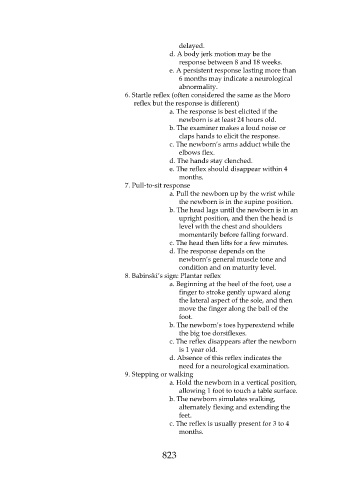Page 823 - Saunders Comprehensive Review For NCLEX-RN
P. 823
delayed.
d. A body jerk motion may be the
response between 8 and 18 weeks.
e. A persistent response lasting more than
6 months may indicate a neurological
abnormality.
6. Startle reflex (often considered the same as the Moro
reflex but the response is different)
a. The response is best elicited if the
newborn is at least 24 hours old.
b. The examiner makes a loud noise or
claps hands to elicit the response.
c. The newborn’s arms adduct while the
elbows flex.
d. The hands stay clenched.
e. The reflex should disappear within 4
months.
7. Pull-to-sit response
a. Pull the newborn up by the wrist while
the newborn is in the supine position.
b. The head lags until the newborn is in an
upright position, and then the head is
level with the chest and shoulders
momentarily before falling forward.
c. The head then lifts for a few minutes.
d. The response depends on the
newborn’s general muscle tone and
condition and on maturity level.
8. Babinski’s sign: Plantar reflex
a. Beginning at the heel of the foot, use a
finger to stroke gently upward along
the lateral aspect of the sole, and then
move the finger along the ball of the
foot.
b. The newborn’s toes hyperextend while
the big toe dorsiflexes.
c. The reflex disappears after the newborn
is 1 year old.
d. Absence of this reflex indicates the
need for a neurological examination.
9. Stepping or walking
a. Hold the newborn in a vertical position,
allowing 1 foot to touch a table surface.
b. The newborn simulates walking,
alternately flexing and extending the
feet.
c. The reflex is usually present for 3 to 4
months.
823

